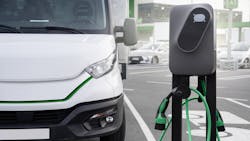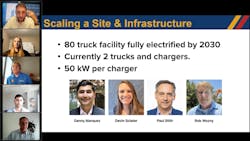Scaling charging infrastructure: Where to begin
What does Where’s Waldo have to do with EV depot charging infrastructure? According to Ari Kahn, developing charging infrastructure in today’s fleets is like finding Waldo in a sea of faces at a train station or, in the illustration Kahn used, at the beach.
Kahn, the carbon-free transportation manager at Rocky Mountain Institute, displayed the Where’s Waldo image in a recent North American Council for Freight Efficiency webinar. “If your electric vehicle is Waldo, this may be what your depot looks like today,” Khan said, representing the state some fleets have found themselves in when navigating fleet electrification.
The next slide showed an image consisting almost entirely of Waldos. “…and this is ultimately where you want to be,” Kahn explained.
His Where’s Waldo illustration pointed out the strategic thought process, planning, and structure required of fleet companies that intend to electrify their fleet.
The webinar on scaling charging infrastructure was produced by the North American Council for Freight Efficiency and Advanced Clean Transportation. It’s the ninth webinar in a 10-part series NACFE is producing ahead of its Run on Less demonstration about electric depot infrastructure.
See also: NACFE sets sights on electric depots for next Run
Kahn hosted the webinar, and the panelists consisted of Danny Marquez, director of products and services at Xos Trucks; Devin Sclater, business development manager of fleet and transit solutions at ABB; Paul Stith, assistant vice president of global transportation initiatives at Black and Veatch; and Rob Wozny, product manager of EV charging at Shell.
The discussion surrounded a hypothetical scenario in which an 80-truck facility—with a goal of being fully electric by 2030—currently employs two electric trucks and two temporary chargers. The panelists shared insight on steps the facility would need to take to scale the charging equipment to meet those requirements.
Build in increments
Rolling out EVs in a fleet doesn’t happen overnight. Marquez said having just two EVs in a fleet won’t go very far in helping determine if EVs are a perfect fit for the business.
“If you’ve only deployed two vehicles and a few chargers, you’re probably going to want to scale up just a little bit more to really understand how EVs are going to plug into your operations before hitting the gas on electrification goals,” Marquez said.
He said building the charging infrastructure is a complex process, which involves permitting, construction, commissioning, and understanding kilowatts and kilowatt-hours. The difference in infrastructure for two vehicles versus a whole fleet is significant and something fleets shouldn’t rush into.
Once infrastructure is built, “your chargers are also going to become part of your fleet,” Marquez explained. “They’ll come with downtime; they’ll have issues.”
Because the chargers alone will take time to integrate into operations, Marquez suggests fleets test the EV impact on their operations by first scaling up 5, 10, and 15% of their fleet. Scaling EV operations from 15% will give managers confidence in what a 100% electrification journey will look like, and fleets can accelerate from there, Marquez said.
Scaling in increments was a point Wozny also mentioned. He said understanding a fleet’s ultimate electrification goal is incredibly important.
“Get an understanding of where you may be going in the long run … and get started,” Wozny began. “And if you can, do that in blocks.”
He said that by installing charging infrastructure in a block pattern or in segments, “you can bring down the costs, you can scale pretty easily, and it gives you more opportunity to evaluate what else is out there as technology changes.”
See also: NACFE sets out to study how fleet depots are scaling up EV adoption
Energy requirements
Each panelist honed in on the importance of determining energy requirements before trenching the ground to lay cable.
To do this, Marquez said fleet managers should first determine a few things: which routes are the shortest and most predictable, what battery capacity is necessary to run that route, and how long will it take take a vehicle to charge.
“At a bare minimum, from those variables, you can then start thinking about what size of chargers you’re going to install at the facility,” Marquez said.
Stith said once energy requirements are established, fleet managers can determine the best way to optimize that in the fleet. Will all vehicles be charged simultaneously, or can vehicles be charged at staggered times throughout the day?
In line with Wozny, Sclater said fleets must also determine their goal, whether that’s to eventually be carbon neutral or to electrify 80% of the fleet by 2030. Knowing what the end point looks like, planning to get there, taking an intelligent approach to that plan, and making sure equipment purchased on the way can also be used when the goal is achieved are steps fleets should take, Sclater said.
“Having that forethought really helps with scaling that infrastructure,” Sclater emphasized.
See also: CEVIC 2023 explore the future of fleet electrification
Although it’s fun to search for Waldo at the train station, the beach, or the circus, it’s not fun running a fleet depot that can be compared to the popular search-and-find books. Building charging infrastructure in increments and determining a fleet electrification end goal can help a fleet depot avoid being compared to the man with glasses and a red-striped shirt.
About the Author
Jade Brasher
Senior Editor Jade Brasher has covered vocational trucking and fleets since 2018. A graduate of The University of Alabama with a degree in journalism, Jade enjoys telling stories about the people behind the wheel and the intricate processes of the ever-evolving trucking industry.




